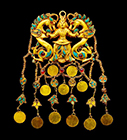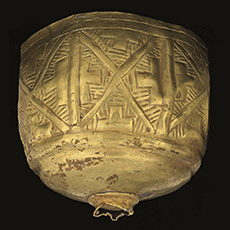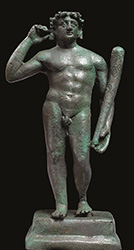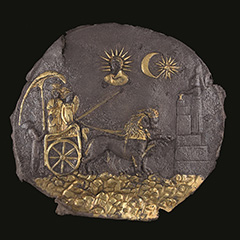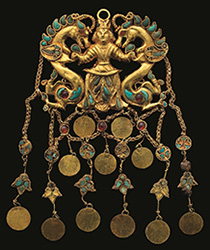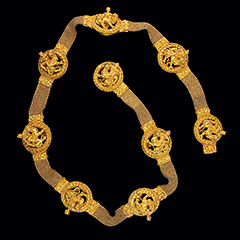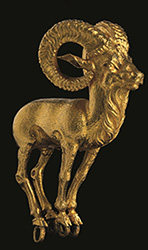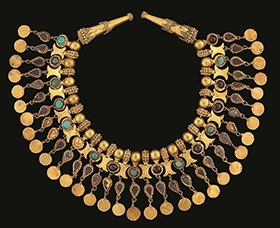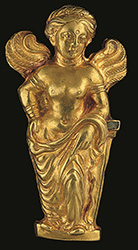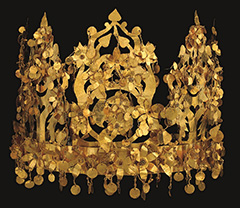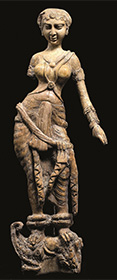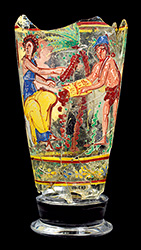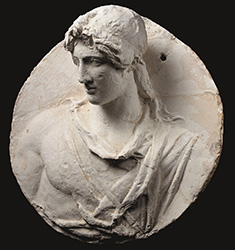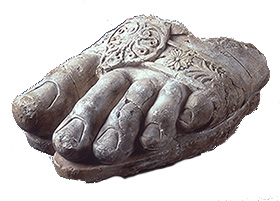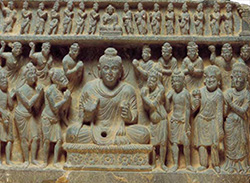2016年5月31日(火)、入場者が10万人に達しました。
1089ブログ「黄金のアフガニスタン-守りぬかれたシルクロードの秘宝-」 展覧会の見どころなどを紹介しています。
東京国立博物館資料館 特別展「黄金のアフガニスタン-守りぬかれたシルクロードの秘宝-」関連図書コーナー設置
展覧会のみどころ
第1章 テペ・フロール
先史時代(前2100年~前2000年頃)
アフガニスタンの北東部で、1966年に偶然発見された紀元前2100~紀元前2000年頃の青銅器時代の遺跡で、金銀器を副葬した墓地の一部と推定されています。この遺跡は当時から貴重品だったラピスラズリの原産地に近く、テペ・フロールはメソポタミア文明とインダス文明とをつなぐ役割を担っていたと考えられています。
幾何学文脚付杯
前2100年~前2000年頃
アフガニスタン国立博物館蔵
文明交流を語る黄金のゴブレット
金製で中央アジアの青銅器時代に特徴的なゴブレット(脚台付の杯)です。本来は、平底の小さな脚が付いていましたが、残念ながら現在は失われています。外面に表された「凸形」モチーフは、祭祀に関連した文様として、アフガニスタン、ウズベキスタン、トルクメニスタンなどで、紀元前5000年頃から、約3千年間にわたって使われています。
展覧会のみどころトップへ
第2章 アイ・ハヌム
グレコ・バクトリア王国時代(前3世紀~前2世紀)
紀元前4世紀、マケドニアのアレクサンドロス大王は東方に遠征し、アフガニスタンの地を訪れました。
その後、紀元前300年頃にアフガニスタン北部に作られたギリシア人の植民都市がアイ・ハヌムです。アクロポリスと2本の川で囲まれた要害の地に、神殿、宮殿、体育場、半円形の劇場などが築かれ、見事なギリシアの都市が建造されました。コリント式の柱頭を用いた建築、ギリシア語碑文、ギリシアの神々の像が出土し、まさに東方に華開いたヘレニズム文化がよみがえります。
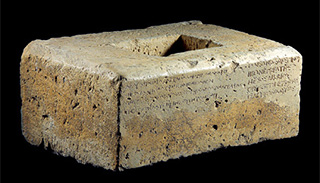 ギリシア語刻銘付石碑台座
ギリシア語刻銘付石碑台座
前3世紀初め
アフガニスタン国立博物館蔵
神より告げられた人生訓が刻まれた台座
ギリシア語で書かれたこの銘文は、アイ・ハヌムの創始者の1人とされるキネアスというギリシア人に捧げられたものです。その言葉の中にデルフォイの神託の 一部が含まれています。ギリシア中部にあるデルフォイには美しい青年の神アポロンの神殿があり、古代ギリシア人がここで受けた神託は、政治や外交のみなら ずあらゆることを規定しました。
ヘラクレス立像
前150年頃
アフガニスタン国立博物館蔵
英雄ヘラクレスの肉体美
アイ・ハヌムの中心部にある神殿から出土しました。ヘラクレスは怪力無双の勇者で、ギリシア神話の英雄です。若々しくたくましい体つきで、左手には武器の棍棒をかかえています。ギリシア神話のヘラクレスへの信仰が東方世界へも大きな広がりをみせていたことの証です。葉で作られた冠を自らかぶるのは、バクトリアに独特の姿です。
キュベーレ女神円盤
前3世紀
アフガニスタン国立博物館蔵
車に乗った大地の女神
大きな冠をつけたキュベーレが有翼の女神ニケを従えて、2頭の獅子が引く戦車に乗っています。天空の中央に太陽の神ヘリオスが燦然と輝き、横に三日月と星があります。キュベーレは小アジアからギリシアで信仰された大地の女神、ニケは勝利を象徴するギリシアの神、戦車の形はペルシャ風で、多様な文化がこの1枚の円盤に凝縮されています。
展覧会のみどころトップへ
第3章 ティリヤ・テペ
サカ・パルティア時代(前1世紀~1世紀)
地元の言葉で「金の丘」を意味するティリヤ・テペ。アフガニスタンの北部に位置するこの地で、1978年、遊牧民族の有力者の墓が手つかずの状態で発見されました。6基の墓に埋葬されていたのは女性5人と男性1人で、副葬された愛用品や身に着けていた装身具、衣服にちりばめられた装飾品には金やトルコ石がふんだんに用いられ、「バクトリアの黄金」と称されるにふさわしい輝きを放っています。その繊細な造形美や人物・動物の表情などは多くの人々を魅了します。
ドラゴン人物文ペンダント
1世紀
アフガニスタン国立博物館蔵
ドラゴンをあやつる王の飾り
2号墓に葬られた女性の髪を飾っていた装飾品です。宝石を鎖で繋いだ美しさは目にも耳にも訴えかけます。中央には、遊牧民族の衣装を身につけ、冠をかぶった男性が立ち、両側のドラゴンとおぼしき神話上の動物を両手でつかんでいます。躍動感に満ちた姿は、遊牧民族の世界観を印象づけます。
メダイヨン付腰帯
1世紀
アフガニスタン国立博物館蔵
シルクロードの英雄を飾った黄金のベルト
8本の金の鎖を編んで作られた腰帯です。4号墓に埋葬された長身の男性が身につけていました。散りばめられたメダイヨンの中央には、水瓶を持ち豹のような動物にまたがる人物像が表現されています。その姿はギリシアの神ディオニソスを彷彿とさせますが、自身の乳房(?)を右手で示すポーズは、ギリシアの図像表現に類を見ない特異なものです。バクトリアの地で独特の文化が醸成されていたことを示す優品です。
牡羊像
1世紀
アフガニスタン国立博物館蔵
生きているようなムフロン羊
前後の脚を揃え、前方をまっすぐ見つめる牡羊像。ムフロンと呼ばれる山岳地帯に生息する種を表現したものです。髪飾かと思われ、羊の頭部にはさらに装飾を挿すための筒があります。いきいきとした顔立ちや、流れるようなあごひげ、ひづめの細部にいたるまで写実性を極めた造形は、比類ない技術の高さを示しています。
襟飾
1世紀
アフガニスタン国立博物館蔵
金、トルコ石、ガーネットの贅を尽くした飾り
5号墓に埋葬された若い女性の襟元を飾っていた装飾品です。2種類のパーツを交互に配置することで、変化に富みながらも統一感のある襟飾に仕上がっています。1つは、内側から中が空の丸いビーズにトルコ石かガーネットの飾りがつき、アーモンド形の貴石と円形飾板が続くペンダントです。もう1つは、粒状装飾がついた金環に、背合わせになった三日月形の飾板がつき、アーモンド形の貴石、円形飾板と続くペンダントです。
アフロディーテ飾板
1世紀
アフガニスタン国立博物館蔵
翼をもつアフロディーテ
翼をもつ女性を象った金の飾板です。下半身を覆う衣に手をかけるその姿は、ギリシア神話の女神、アフロディーテです。ヘレニズムの影響を受けた容姿は、ミロのヴィーナスのような美しさですが、翼をもつ表現やその表情にはアジア文化との融合がみられます。
冠
1世紀
アフガニスタン国立博物館蔵
王妃のしるし、黄金の冠
6号墓に葬られた女性の頭部を飾る金の冠です。5つの樹形の立ち飾りはハート形や三日月形に切り抜かれ、鳥も表現されています。貼り付けられた六つ葉のロゼッタからは小さな円形の瓔珞がきらびやかに下げられています。帯と樹形の立ち飾りはそれぞれ取り外しが可能で、遊牧民族らしい工夫といえるでしょう。この造形美は奈良県藤ノ木古墳の冠にもみられるように、遠く東アジアまで広まりました。
展覧会のみどころトップへ
第4章 ベグラム
クシャーン朝時代(1~3世紀)
ベグラムは首都カブールの北約70km、海抜1,600mの高地にある都市遺跡です。1~3世紀に中央アジアから北インドを支配したクシャーン朝の夏の都で、古代のカーピシー国の首都でもありました。都城の中で、入り口をレンガで厳重にふさいだ2つの部屋を発掘したところ、ローマやエジプトなど地中海世界のガラスや青銅、石膏製品、インドの象牙製品、また中国の漆器などが大量に発見され、大きな注目を集めました。
ギリシア・ローマの神々やインドの女神像、色鮮やかなガラス製品などは、シルクロードを経由した東西交易がさかんだったことを物語っています。
マカラの上に立つ女性像
1世紀
アフガニスタン国立博物館蔵
象牙製の妖艶なインドの女神
豊満な体つきで体をくねらせたなまめかしい姿の女性が、インド神話の怪魚マカラの上に立っています。マカラは水と深く関わる神秘的な動物で、その上に立つ女性は川の神と考えられます。インドの象牙は古代社会で大変に珍重され、ベグラムからは数百点にのぼる象牙製品が出土しました。インドの象牙はローマへも輸出されていました。
脚付彩絵杯
1世紀
アフガニスタン国立博物館蔵
若き男女を描いたガラス杯
ナツメヤシの収穫あるいは花を集めて花輪を編む場面を、黄色や青、赤を巧みに使って色鮮やかに描き出しています。ガラス質の顔料であるエナメルで絵付けをして焼き付ける技法は、エジプトで発達し地中海世界に広まりました。ベグラムのガラス器は、吹きガラスや透かし模様、ミルフィオーリなど当時の最高技術を駆使しています。
青年上半身メダイヨン
1世紀
アフガニスタン国立博物館蔵
物思う青年
向かって左前方をみつめている青年上半身像です。細いヘアーバンドでまとめた髪は、背中まで伸びています。石膏で作られたこのようなメダイヨンは、同様の図柄を銀器の装飾に用いるための見本として使われたもので、ギリシア・ローマの神話を主題とする作品が数多く見つかっています。
展覧会のみどころトップへ
第5章 アフガニスタン流出文化財
アフガニスタン国内が混乱を極めていたさなか、アフガニスタン国立博物館や国内各地の遺跡から多数の文化財が略奪されました。 不法に国外に持ち出された文化財の一部はわが国にも運ばれました。シルクロードを生涯のテーマとして描き続けた日本画家でユネスコ親善大使を務めた平山郁夫氏は2001年、これらの「流出文化財」を「文化財難民」と位置づけ、ユネスコの同意のもと「流出文化財保護日本委員会」を設立し、 再びアフガニスタンに平和と安定が戻るまでわが国で保護することを提唱しました。同委員会は、これに賛同した人々から譲渡された文化財を保全管理し、必要に応じて修復を行いました。本展では、この機にアフガニスタンへ無事に返還されることになった102件のうち、15件が特別出品されます。
ゼウス神像左足断片
前3世紀
アイ・ハヌム出土
流出文化財保護日本委員会保管
神々の王、ゼウスの左足先
複雑に隆起する造形が強い迫力を持った古代彫像の傑作です。グレコ・バクトリア王国の都市アイ・ハヌム遺跡から発見されたゼウス神像の左足であり、文明の東西交流を象徴します。大理石は極めて貴重であったため、頭部や手足以外は土や漆喰で造られていたと考えられます。
カーシャパ兄弟の仏礼拝(部分)
2~3世紀
ショトラク出土
流出文化財保護日本委員会保管
仏陀をあがめる弟子たち
インドの火の神アグニを信奉するカーシャパ三兄弟は、仏陀の神通力を目の当たりにし、弟子千人とともに仏教へ改宗したという仏伝の一コマを表しています。正面を見つめる中央の仏陀はひときわ大きく表され、その周りを行者の姿をした三兄弟と弟子や天人たちが囲んでいます。この作品は国立博物館を代表する仏教美術の名品でしたが、1992年に盗難に遭い、パキスタン経由で日本に持ち込まれました。
展覧会のみどころトップへ

